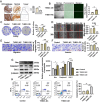Up-regulation of thrombospondin-1 inhibits the progression of gallbladder cancer
- PMID: 40259006
- PMCID: PMC12011972
- DOI: 10.1007/s12032-025-02719-z
Up-regulation of thrombospondin-1 inhibits the progression of gallbladder cancer
Abstract
Gallbladder cancer, the most prevalent malignant neoplasm of the biliary tract, has garnered significant attention due to its dismal prognosis and high degree of malignancy. Identifying key regulatory genes is crucial for the development of effective therapeutic strategies. The differential gene expression in biliary tract malignancies was identified using the Gene Expression Omnibus (GEO) database. Subsequently, the interactions among these differentially expressed genes were analyzed employing the STRING database, and the resultant regulatory network was visualized using Cytoscape software. Utilizing the Cytoscape plugin CytoHubba, the core genes within the network were identified, followed by Gene Ontology (GO) and Kyoto Encyclopedia of Genes and Genomes (KEGG) pathway enrichment analyses. Ultimately, the overexpression of THBS1 in the gallbladder cancer cell line (NOZ) was achieved through lentiviral transfection and both in vivo and in vitro experiments were conducted to evaluate its effects. We found that thrombospondin-1 (THBS1) was the core gene of gallbladder cancer and its expression was low in gallbladder cancer. Experimental data, both in vivo and in vitro, indicate that the up-regulation of THBS1 exerts an inhibitory effect on the proliferation, migration, and invasion of gallbladder cancer cells. Furthermore, it facilitates the process of apoptosis and suppresses tumor growth and angiogenesis. The expression of THBS1 is low in gallbladder cancer. Up-regulation of THBS1 can effectively inhibit the occurrence and development of gallbladder cancer and can be used as a biomarker for the diagnosis and treatment of gallbladder cancer.
Keywords: Biomarker; Gallbladder cancer; THBS1.
© 2025. The Author(s).
Conflict of interest statement
Declarations. Conflict of interest: The authors declare no competing interests. Ethical approval: All studies involving human specimens obtained the written informed consent of patients, and all animal experiments followed the guidelines of the China Animal Protection Association. This study was approved by the ethics committee of Bengbu Medical College (ethical approval (2023) No. 111/(2024)184).
Figures




Similar articles
-
Importin-11 overexpression promotes the migration, invasion, and progression of bladder cancer associated with the deregulation of CDKN1A and THBS1.Urol Oncol. 2018 Jun;36(6):311.e1-311.e13. doi: 10.1016/j.urolonc.2018.03.001. Epub 2018 Mar 27. Urol Oncol. 2018. PMID: 29602637
-
THBS1 knockdown suppresses pancreatic cancer progression through JAK2/STAT3 signaling pathway.Mol Cell Probes. 2025 Feb;79:102003. doi: 10.1016/j.mcp.2024.102003. Epub 2024 Dec 26. Mol Cell Probes. 2025. PMID: 39710065
-
Apatinib inhibits glioma cell malignancy in patient-derived orthotopic xenograft mouse model by targeting thrombospondin 1/myosin heavy chain 9 axis.Cell Death Dis. 2021 Oct 11;12(10):927. doi: 10.1038/s41419-021-04225-2. Cell Death Dis. 2021. PMID: 34635636 Free PMC article.
-
NUF2 and NEK2 promote malignant progression of gallbladder cancer by remodeling the extracellular matrix.Carcinogenesis. 2025 Apr 3;46(2):bgaf019. doi: 10.1093/carcin/bgaf019. Carcinogenesis. 2025. PMID: 40220284 Free PMC article.
-
Overexpression of SNORA21 suppresses tumorgenesis of gallbladder cancer in vitro and in vivo.Biomed Pharmacother. 2019 Oct;118:109266. doi: 10.1016/j.biopha.2019.109266. Epub 2019 Aug 8. Biomed Pharmacother. 2019. PMID: 31401397
References
-
- Roa JC, Garcia P, Kapoor VK, Maithel SK, Javle M, Koshiol J. Gallbladder cancer. Nat Rev Dis Primers. 2022;8:69. - PubMed
-
- Feo CF, Ginesu GC, Fancellu A, Perra T, Ninniri C, Deiana G, Scanu AM, Porcu A. Current management of incidental gallbladder cancer: a review. Int J Surg. 2022;98: 106234. - PubMed
-
- Krell RW, Wei AC. Gallbladder cancer: surgical management. Chin Clin Oncol. 2019;8:36. - PubMed
-
- Schmidt MA, Marcano-Bonilla L, Roberts LR. Gallbladder cancer: epidemiology and genetic risk associations. Chin Clin Oncol. 2019;8:31. - PubMed
-
- Marcinak CT, Abbott DE. Gallbladder cancer. Cancer Treat Res. 2024;192:147–63. - PubMed
MeSH terms
Substances
LinkOut - more resources
Full Text Sources
Medical
Miscellaneous

